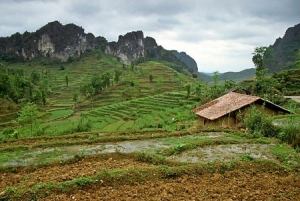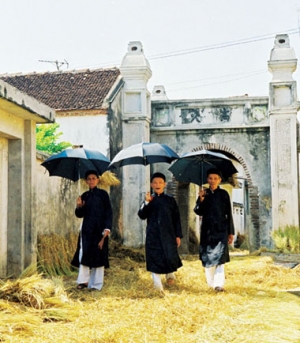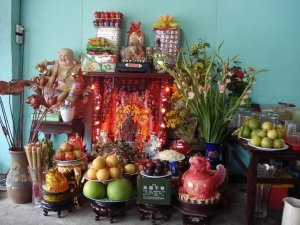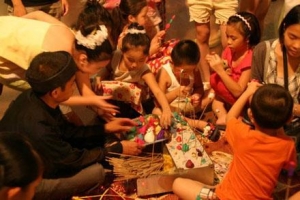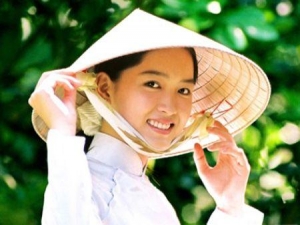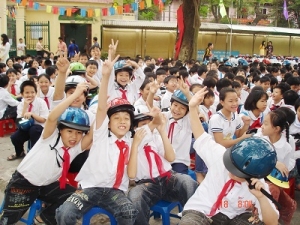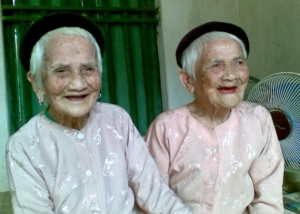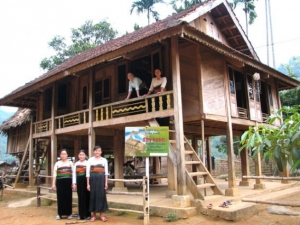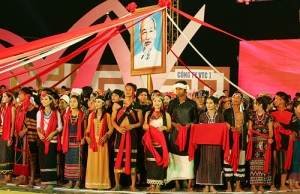
Asia Pacific Travel Team
Cao Bang's culture
Cao Bang's culture is diversified by the cultural harmony of many minority and majority groups.
The main groups in Cao Bang are Tay, Nung, Dao, San Chi, Kinh, Mong and Hoa of whom Tay ethnic group accounts for 42 per cent, Nung ethnic group occupies 35 per cent, the rest are other groups such as Dao (9.8 per cent), H'mong (6.3 per cent), Kinh (5.5 per cent), etc. Each group enjoys their own typical, traditional heritages of culture.
These groups live in community in different regions. Kinh people often live in town, where has favorable conditions for relations exchange and trade.
The Tay people occupy a great number in the province, mainly living in almost districts. They have long standing culture, their own writing ( Tay - Nung language group). The Tay's abundant culture is manifested in Sli luon singing, Then singing, Luon Sluong, Luon coi, Luon ngan, sluong dancing, Chau dancing, Dan tin (a musical instrument), Phuong ly. Tay man wore indigo-blue Ao dai, white trousers, turban with its point on the back, and fabric shoes. Tay woman rolled their hair, and covered with square scarf. They wore indigo-blue Ao dai, fastening buttons on the right, tying an indigo-blue string around their waist with 2 long ends. The indigo-blue fabric is woven, and dyed by Tay people.
Nung ethnic people live together with Tay people in different geographical divisions. Nung group has many branches. Basing on clothes and language, Nung branches can be divided into Nung Inh, Nung An, Nung Loi, Nung Giang, etc. The Nung's clothes are more abundant depending on branches but the main characters are similar. Nung woman's clothes have big sleeves. Wristband and collar are decorated with colorful pieces of cloth. Nung group enjoys fan dancing, scarf dancing, two string violin, tintinnabulum, bronze shaken set, Da hai singing - an ancient classical drama, which was formed 300 years ago and has been restored nowadays.
Dao people are hard working, mainly distributed in low hill, mountainous regions. They are farming in fields and gardens and still have backward customs. Dao people's clothes are typical and diversified in forms. The typical Dao branches in Cao Bang are Dao tien and Dao do. Dao do woman wore very luxurious. On black fabric foundation, red pieces of cloths are embroidered or glued up. Ca pha scarf with 8 full spans of arm length is rolled around their head, like a hat brim. A band of pha xi fabric, which are embroidered vignettes by red thread, rolls around their body. A xi lo chin meticulous embroidered belt with complicated patterns rolls around their waist, hanging down the back.
Lap of dress is decorated complicated. The dress comes down to their knee, and is low-necked. The sleeves are large, decorated on edges. Inside the dress, the woman wears a bright brassiere, hanging two strings of cotton balls (nom lang gau). Each string has eight cotton balls. Their trousers have big legs, and are decorated with green, or red, brown, white squares. They put a square piece of nom kie fabric on their back to show their decoration, embroidery talent. Dao people have Chuong dancing, drum dancing.
H'mong minority group stays in high mountains, remote areas, mainly in Bao Lac, Ba Be, Thong Nong, Ha Quang. They live nomadic, setting fire on mountain field for cultivation, mainly growing maize. H'mong people have umbrella dance, Khen dance, Khen la, Khen moi.
Hoa group lives in town. They have developed economic standard.
Vietnamese village’s guilds custom
The Vietnamese culture has always evolved on the basis of the wet rice civilization. Thus, the lifestyle of the Vietnamese population is closely related to its village and native lands.
The Vietnamese culture has evolved from the basis of a wet rice cultivating civilization. Because of this, the lifestyle of the Vietnamese population is closely related to native villages and lands.
In Vietnamese society, people gathered together to form villages in rural areas and guilds in urban areas. These villages and guilds have been forming since the dawn of the nation. The organization gradually developed, steadily becoming more stable and closer together. Each village and guild has its own conventions.
The purpose of the conventions is to promote good customs within populations and organizations. All are different, but of course are always in accordance with state law.
There are tens of thousands of such conventions safety kept in the History Museum in Hanoi and other museums throughout the country
Worship of Ancestor Custom
A very popular belief among Vietnamese is the custom of the ancestor cult. In every household, an ancestor altar is installed in the most solemn location.
Vietnamese believe that the soul of a dead person, even if dead for many generations, still rests along with their descendants on earth. The dead and living persons still have spiritual communion; in everyday life, people must not forget that what they enjoy and how they feel is the same for their dead relatives.
On the last day of every lunar year, an announcing cult, cung tien thuong, is performed to invite the dead forefathers to return home to celebrate Tet holidays with their families. During the last days before Tet, all family members visit their ancestors’ graves; they clean and decorate the graves, in the same manner that the livings clean and decorate their houses to welcome the New Year.
On the anniversary of an ancestor’s death, descendants and relatives unite and prepare a feast to worship the dead people and to ask for health and happiness for themselves. From generation to generation, ancestor worshipping customs have been religiously preserved. There are some small variations between those customs among the many Vietnamese ethnic groups, but the common theme of fidelity and gratitude towards the ancestors remains.
Villages – Guilds
The Vietnamese culture has always evolved on the basis of the wet rice civilization. Thus, the lifestyle of the Vietnamese population is closely related to its village and native lands.
In Vietnamese society, people gather together to form villages in rural areas, and guilds in urban areas. Villages and guilds have been forming since the dawn of the nation. These organizations have gradually developed for the population to be more stable and closer together. Each village and guild has its own regulations called conventions.
The purpose of these conventions is the promotion of good customs within populations. All the conventions are different but they are always in accordance with the state laws.
Approximately ten thousands such conventions are kept in the History Museum inHanoi and in other museums throughout the country.
Customs of Chewing Betel and Areca Nuts and smoking thuoc lao
According to legends, chewing quid of betel and areca has been a custom since the Hung Vuong period and is connected to the antique legend of betel and areca.
A quid of betel, also called trau, is composed of four elements: an areca leaf (sweet taste), betel bark (hot taste), a chay root (bitter taste), and hydrated lime (pungent taste). The custom of chewing betel nut is unique to Vietnam. Old health books claim that “chewing betel and areca nut makes the mouth fragrant, decreases bad tempers, and makes digesting food easy”. A quid of betel makes people become closer and more openhearted. At any wedding ceremony, there must be a dish of betel and areca nut, which people can share as they enjoy the special occasion.
During festivals or Tet Holidays, betel and areca nut is used for inviting visitors and making acquaintances. Sharing a quid of betel with an old friend is like expressing gratitude for the relationship. A quid of betel and areca nut makes people feel warm on cold winters days, and during funerals it relieves sadness. Betel and areca nuts are also used in offerings. When Vietnamese people worship their ancestors, betel and areca nut must be present at the altar. Nowadays, the custom of chewing betel remains popular in some Vietnamese villages and among the old.
Let’s not forget to mention thuoc lao or strong tobacco. For women, betel can initiate various feminine conversation, but for men, thuoc lao is related to their joyfulness as well as the sadness in their lives.
Peasants always carry their dieu cay (pipe for smoking while ploughing the rice fields).
Wedding Ceremony
Getting married is an important event in a Vietnamese’s life. The procedure of the ancient wedding ceremony was very complicated. Current wedding ceremony procedures include the following steps: the search for a husband or wife, the proposal, the registration, and finally the wedding.
Depending on habits of specific ethnic groups, marriage includes various steps and related procedures, but generally there are two main ceremonies:
Le an hoi (betrothal ceremony): Some time before the wedding, the groom and his family visit the bride and her family with round lacquered boxes known as betrothal presents composed of gifts of areca nuts and betel leaves, tea, cake, fruits, wines and other delicacies covered with red cloth and carried by unmarried girls or boys. Both families agree to pick a good day for wedding.
Le cuoi (wedding ceremony): Guests would be invited to come to join a party and celebrate the couple’s happiness. The couple should pray before the altar asking their ancestors for permission for their marriage, then to express their gratitude to both groom’s and bride’s parents for raising and protecting them. Guests will share their joy at a party later.
Funeral Ceremony
“The sense of the dead is that of the final,” says a Vietnamese proverb, meaning that funeral ceremonies must be solemnly organized.
Formerly funeral ceremonies went as following: the body was washed and dressed; then a le ngam ham, or chopstick, was laid between the teeth and a pinch of rice and three coins were dropped in the mouth. Then the body was put on a grass mat laid on the ground according to the saying “being born from the earth, one must return back to the earth.” The dead body was enveloped with white cloth, le kham liem, and put into the coffin, le nhap quan. Finally, the funeral ceremony, le thanh phuc, was officially performed.
The deceased person’s sons, daughters, and daughters-in-law had to wear coarse gauze turbans and tunics, and hats made of straw or of dry banana fiber. The deceased person’s grandchildren and relatives also had to wear mourning turbans. During the days when the dead were still laid out at home, the mourning went on with worshipping meals and mourning music. Relatives, neighbours, and friends came to offer their condolences.
The date and time for the funeral procession, le dua tang, must be carefully selected. Relatives, friends, and descendants take part in the funeral procession to accompany the dead along the way to the burial ground. Votive papers were dropped along the way. At the grave site, the coffin is buried and covered. After three days of mourning, the family visits the tomb again, le mo cua ma or worship the opening the grave; after 49 days, le chung that, the family stops bringing rice for the dead to the altar. And finally, after 100 days, the family celebrates tot khoc, or the end of the tears. After one year is the ceremony of the first anniversary of the relative’s death and after two years is the ceremony of the end of mourning.
Nowadays, mourning ceremonies follow new rituals which are simplified; they consist of covering and putting the dead body into the coffin, the funeral procession, the burial of the coffin into the grave, and the visits to the tomb. The deceased person’s family members wear a white turban or a black mourning band.
Culture values and customs family
The family is the most important of all social units in Vietnam. In contrast to the focus on individualism in the West, the close-knit family is the basic unit in Vietnamese society.
"Hieu", or filial piety, is one of the basic virtues. This refers to the idea of love, care, and respect that children give their parents. This obligation is unconditional, even in the case of a parent who abandons the children or does not fulfill his or her parental duties. Children are taught this virtue from a very young age (see THE ROLE OF CHILDREN). The socialization process normally begins at home with the teachings from grandparents and parents. This educational process continues throughout a child`s early years and is reinforced throughout all the social institutions.
One of the most well known Vietnamese proverbs is "Cong Cha nhu nui Thai Son, Nghia Me nhu nuoc trong nguon chay ra. Mot long tho Me kinh Cha, cho tron chu hieu moi la dao con," or The debt we owe our father is as great as Mount Thai son; the debt we owe our mother is as inexhaustible as water flowing from its source. We must repay their debt in order to fulfill our obligations as children" the cradle of traditional Vietnamese society was village place that provided individual with a sense community and security in potentially hostile environment. This along importance family created network extended kinship ties.
In traditional Vietnamese culture, strong individuals in a family have an obligation to the weaker and less fortunate members of the family (or village). Every action of every family member reflects on the family, be it achievement or shame. There is a sense of obligation and of providing for the welfare of each and the entire family. An individual who achieves fame at the expense of the family is discouraged and even sanctioned.
The family in Vietnam was also an extended one, unlike the typical "nuclear" family in the United States. The family traditionally was composed of three to five generations living in the same house, typically including parents, children, grandparents, and sometimes, unmarried uncles and aunts. The extended family acted as a source of mutual support and as an institution where individual problems and social conflicts could be resolved. However, the long history of multiple wars changed the basic structure of the Vietnamese family. Because many family members and individuals were killed during all the different wars, it would be difficult to maintain the expected ancient traditions and practice. Although the family structure fundamentally remains an extended one, in urban areas particularly, the family is limited to three generations: grandparents, parents and children. Vietnam also has patriarchal system where the man, or husband, serves as the head of the family... (See THE ROLE OF MAN). He takes care of money matters and is responsible for providing for the family. The woman (see THE ROLE OF WOMAN) is in charge of the affairs in the home and raising the children.
The role of man
To be a man, one must take four important steps.
First, he must know how to cultivate himself (Tu Than). In order to achieve this step, he must meet five requirements:
1) He must adhere to rites and ceremonies.
2) Strictly observe the family and social hierarchies (Le).
3) He must help the need and desperate (Nghia).
4) He must have strong will power and determination (Chi), and
5) He should consistent and loyal so that people can trust and have confidence in him (Tin).
Then he must govern or run his own family properly (Te Gia). Without these two prerequisites he might not be able to rule the country (Tri Quoc). And after fulfillment of the three above required steps might hie pacify the whole world (Binh Thien Ha).
The Vietnamese man or more accurately the husband is the boss, or he claims to be one. In traditional conditions, he is breadwinner and decision-maker for his family. He is supposedly the most important member of the family and definitely has a higher status than his wife. He has the power to control all the things in the family. When the decisions must be made regarding important issues such as the mirage of his children. He usually consults not only his wife and the children concerned but also other members of his family, such as his parents, his parents in-law, his brothers and sisters, his uncles and aunts, etc. But the final decision is still his, and appropriate actions are taken.
The role of women
Vietnamese woman are highly regarded by Westerners, who find them very graceful and gentle with all sorts of qualities that men look for.
As young girls, they expected to keep their virginity until they get married and to getmarried only once in their life. As married women, they are expected to respect and be faithful to their husbands and accept whatever fate might come. When a woman gets married, she is no longer considered to belong to her family but becomes a member of her husband`s family. In other words, she is assumed to have a new duty and responsibility toward her husband and in-laws only.
Our women are taught to be observe three basic practices:
While they are still under their parents` protection, they must be obedient to their fathers (Tai Gia Tong Phu.)
When they get married, they have to be submissive to their husbands (Xuat Gia Tong Phu).
When their husbands die, they must listen to their grown-up sons (Phu Tu Tong Tu).
Under the old custom and good woman must have four feminine virtues:
1) She must be good at housework, needlework, or any work peculiar to women (Cong).
2) She must have feminine deportment and appearance (Dung).
3) She must speak gently and be careful with her speech (Ngon).
4) She must show good conduct and act in a virtuous way (Hanh).
And last but not least, when they go out, they have to dress properly and they had to have permission from their parents in order to go anywhere.
The role of women has traditionally been confined to the home. They are expected to bring up and educate their children, take care of the household, and not only serve their husbands in every respect, but also their husband`s families as well. They are expected to sacrifice themselves for their husbands and children husbands and children.
The role of children
Vietnamese children are polite and behave themselves at home and outside.
They are subject to discipline, especially at school, and are taught to be absolutely obedient to their older siblings, relatives, and parents. They are also told to obey, respect, and listen to older people.
At home children are expected to help parents, take care of their younger siblings or aging grandparents, and do whatever they can in the way of babysitting, cooking, cleaning, washing, and so on and on, depending on their age and the economic situation of their family.
At school children show great respect for their teachers and school administrators. Discipline is strictly observed, and any violations will result in severe punishments.Courting and dating are never encouraged by the parents nor practiced by the majority of young people. Casual friendship between boys and girls does exist but usually on a reserved basis and under strict control by parents or surveillance by school proctors. Girls tend to get together with girls, boys tend to flock with boys, and the dividing line in most cases is clear-out.
Vietnamese celebration for longevity custom
Each passing year in a person’s life brings esteem and respect to their family and neighborhood.
Formerly, at the age of 40 one was honored for being an old man or woman.
During the Tran Dynasty in the 12th and 13th centuries, the 40 year old emperor gave up his throne to his son to become a Buddhist monk
According to village customs, a man of 50 is to be honored as an old man. Old men stop working and are no longer village officials; however, they are still invited to festivals and to sears in the communal house. Here, they are seated honorably on red-bordered mats.
Showing respect and esteem for the elderly is a tradition that remains today. Nowadays, when grandparents or parents reach the ages of 70, 80 or 90, their children and grandchild organize ceremonies for longevity which are generally held on birthdays or during the spring days during Tet.
Such celebrations are occasions to show devotion and respect to grandparents and parents. Celebrations for longevity, either large or small, manifest the family’s joy in having a relative who has been able to lead a long life.
Today, in almost every village or urban district, there is an association of longevity for the elderly. When reaching the ages of 70 or 80, old women are offered red dresses and other gifts and are invited to be photographed.
Open New House Celebration
In the past, building a house was considered one of the three most important events in Vietnamese life. These were purchasing a buffalo, looking for a wife, and building a house.
Building an own house is very important to Vietnamese. It even shows his position in social structure. Vietnamese who die without ever has his own house is considered poor and disadvantaged.
Open house celebration is a popular customs of Vietnamese. All of friends, relatives and neighbors are invited to a party to share with the house owner happiness. After the party all guests give gifts normally a little money to house owner and also best wishes for health, happiness and a prosperous life.
Introduction about culture of Ethnic minorities in Quang Ninh
Quảng Ninh, as well as being home to native Vietnamese, also features ethnic groups like the Dao, Tày, Sán Dìu, Sán Chay and Hoa.
Essentially, they arrived from the north, having immigrated between 300 and 400 years ago, and are spread throughout the whole province. Population-wise, these groups account for 10.8% of the whole province.
Today, these traditional cultural values are still present among the ethnic groups of Quảng Ninh. Every form of culture bears a distinctive character, clearly expressing the requirements and special characteristics of their way of life. It is what remains special and mysterious in the villages and hamlets where they live.


